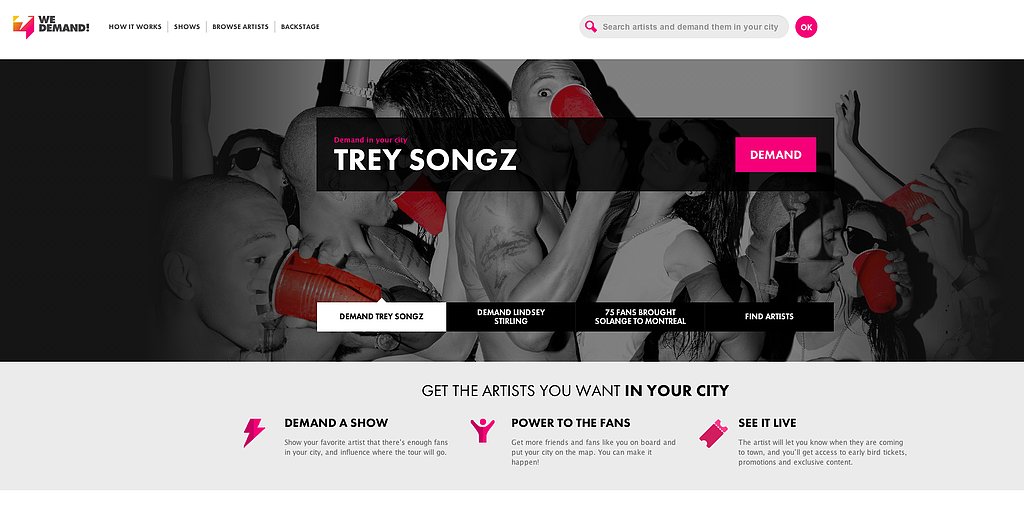Bands That Use Technology
How Technology Is Making It Great to Be a Music Fan
We proudly present this article from our partners at ReadWrite.
By Chris McConnell
![]()
I'm a music junkie. Like many of you, my life is often accompanied by a soundtrack. I've got playlists for working out, and just plain working. Music for when I'm feeling on top of the world, and music for when I'm down in the gutter. Songs that make me think, and songs that bring back memories. Music is important to me — and probably to you as well.
But despite the importance of music, technology is really what allows it to be such a huge part of our lives. So how is tech going to shape the future for music fans like me and you? I needed to find out.
 Source: Flickr user susieq3c
Source: Flickr user susieq3c
I connected with the band Switchfoot — known for the songs "Meant to Live" and "Dare You to Move" — to see if and how they are embracing technology to make their music more enjoyable to fans. What I found is that they're using tech to give their fans more: More access, more content and more control.
This isn't a story about artists making more money. It's a glimpse into what the future has in store for people who love music. People like you and me.
Why Switchfoot?
There's no scientific reason for the choice. I wanted to pick an artist, so I picked one I was a fan of. As it turned out, the way these guys use technology to connect with their followers probably represents a decent cross-section of how artists in general are using tech to engage with fans. Switchfoot has a wide range of experiences that makes it a worthy envoy: The band has been independent, it's been signed to a major label, and it's won a Grammy.
Within minutes of our first conversation, I could tell this band was using technology in innovative ways — especially to create closer connections with fans. According to Switchfoot's bass player Tim Foreman (who majored in computer science and handled the band's early Web development) the band's music — and it's use of technology — is all about connectivity.
"We're part of this greater creative community that includes our fans," Foreman said. "We want to make them co-conspirators with us. They're just as much a part of this as we are. For us as a band, it's all about the conversation, and to that end we're always looking to eliminate barriers between us and the people that listen to our music."
Building Bridges
RebelMouse is a tool Switchfoot uses to simultaneously break down barriers and fuel the conversation. Implemented on one of the band's websites, FadingWest.tv, RebelMouse pulls together tweets, Instagram photos and videos into a single unified hub. As social as social media is, not every fan has an account on every platform. With RebelMouse, fans on one network but not another — Twitter, but not Instagram, or vise-versa — suddenly have access to a treasure trove of content.
As empowering as the band's social media strategy is, Switchfoot has gone even further to include fans in its journey — literally. Switchfoot has used services like WeDemand! to give fans a chance to help shape the touring schedule.
 Source: WeDemand!
Source: WeDemand!
WeDemand! works by allowing fans to raise social support for bringing their favorite artists to areas that may normally be overlooked. Aside from demanding a show, fans can also leave comments for the band on the site. A glance at the band's WeDemand! page shows a large group of commenters requesting a show in Omaha.
Band-to-fan communication is commonplace in the music industry, but fan-to-band communication is finally becoming more common. Switchfoot has also tried to encourage and enable fan-to-fan communication as well: When group messaging service GroupMe was brand new, the band encouraged fans that purchased tickets to download the app in order to communicate with each other while attending concerts and festivals.
A messaging app may not sound like the type of tech a band would be on the lookout for—and in truth, it isn't always a natural fit—but Switchfoot is always looking for benefits that aren't necessarily obvious.
"One of the interesting things I've discovered is that many times the primary use of technologies or services is not actually the primary benefit for us," Foreman said. "For instance, we've used LivingSocial to promote some of our album and tour stuff. Most people are just focused on the sales numbers, but for us, that's not really the main equation there. What's often overlooked is the fact that they have this huge mailing list. So whether you sell 100 or 10,000 tickets, you're reaching millions of eyeballs. I think a lot of technology and services out there have a second layer that is beneficial but often overlooked."
Some services do offer obvious benefits, and the band has those covered, too. Will Call is an app that offers fans a better concert experience by helping them coordinate with other friends at the show, buy merch from their phones without having to face frenzied crowds, and even discover more concerts to attend. Switchfoot has been an early adopter of the Will Call service, which is currently only available in San Francisco, New York ,and Los Angeles.
An Organized Strategy
Switchfoot doesn't just stumble across new technology and decide to use it willy-nilly. Bruce Flohr, the band's manager and an executive at Red Light Management, is dedicated to finding new tech that fits with the band's desires to connect with fans.
So what's his strategy? Flohr says he's not just looking for the next Snapchat or Twitter.
"We're trying to find things that make sense for our fans," he said. "We look at things that fit into our fan's lifestyle and try to work with technologies in that space."
Flohr said it all comes down to one simple test: "The first question I ask is, 'Would I use this?' Because if it's too complicated, then it's very hard to get the early adopters on board."
One piece of technology that passed Bruce's test was Square, the payment platform led by Twitter co-founder Jack Dorsey. At Switchfoot's latest BroAm charity surf event in San Diego, volunteers were sent out with Square-equipped iPads to collect donations from the crowd of 11,000 people.
Though Square made it easy to collect donations for the band, the iPad has become instrumental for Switchfoot in other ways, including the way the band records.
"The iPad has become this incredible multi-instrument that let's you do things that aren't possible any other way," Foreman said. "It's exciting. Just the tactile nature of the iPad allows you to play certain instruments that don't exist. You can sample things and manipulate them in ways you couldn't otherwise and we did a lot of that on the new record."
Foreman said many musicians tend to favor old gear like amps and guitars, but the bassist insisted Switchfoot enjoys exploring new tech.
"I think it's exciting to kind of let go of that for a second and be freed of those constraints and look at everything as an instrument and a possibility," Foreman said.
The Internet Isn't Always Friendly
There have been times when technology has gotten in the way of the band's connectivity to its fans.
About 10 years ago when the band was signed with Columbia Records, the label was experimenting with copy protection. One of the band's albums — Nothing Is Sound, which debuted at No. 3 on the Billboard 200 albums chart — was included in the experiment … without the guys' prior knowledge. Foreman explains:
"We got our copy of the album a couple of days before it was released to the public and saw this big disclaimer on the back and found out that it had this protection that didn't allow you to put it on your iPod (which at the time was already a huge deal). And we were just so offended that they would put out this message that basically tells our fans that we don't trust them. We felt it was the most disingenuous thing that could possibly be put on our album."
At that point, Foreman's background in computer science kicked in and he posted a hack on the band's message boards to let fans circumvent the copy protection to "use the music they purchased and owned how they wanted." According to Wikipedia, the workaround was quickly deleted by Sony.
Giving Fans What They Want
By now you've probably picked up on an emerging theme. We've already seen how the band has used services like RebelMouse to surface and amplify fan-generated content, but technology is also allowing the band to produce more content themselves.
In the future, harnessing, organizing and interpreting community information will help the band determine what kind of content to produce.
"Data can help the band give the consumer what they want," Flohr said. "More and more we're finding they might not want an entire album's worth of material once every two years. They may want more material sooner and better experiences on the live side."
Did you glaze over that last statement or did it sink all the way in? Because it's important.
You, me, us, as music fans—we may be literally shaping what our favorite artists will produce in the future. We, the consumers, are really the ones being empowered, thanks to all of this technology.
The future of being a music fan is sounding pretty good right now, but it's also looking better visually thanks to the welcome onslaught of quality video content heading our way. It's only natural: As the makers of our devices and the networks that connect them build their pipes to be larger and more connected, there will only be more demand for water ("content").
Water, Water, Everywhere
There are plenty of ways fans can get extra content these days, especially with all the "behind-the-scenes" goodies out there.
Flohr told me how music fans can use services like SoundHound to ID songs and unlock second-screen experiences with exclusive video content from the band. There's GoPro footage taken on-stage, brief five-minute video podcasts with tour updates, and even webcam setups in recording studios — Switchfoot has kept busy producing this video content, and last year, it even made a feature-length film to accompany the band's latest album. The two projects share the same name: Fading West.
The Fading West movie is a chance for fans to further immerse in the band's story. "The smart artists realize that they are storytellers and Switchfoot is a perfect example of that," Flohr said. "Fading West is not a music documentary, it's not a concert film. It's a story of the band's passion of both music and surfing and how they've been able to incorporate both into their lives and how both have influenced their career."
The film adds new depth to the group's music and history, but after I watched it, I also felt like I'd gotten to know new friends. The film made me laugh, it made me sad, and it showed me things I didn't expect to see. In short, it was great content. Content that my device — and inner fan — both craved. Content I'd like more of. (Fortunately for me, the YouTube lifestyle network focused on extreme sports called "Network A" partnered with Switchfoot to release some exclusive behind-the-scenes footage.)
Switchfoot's movie — and the pipes that allow it to be delivered to new and existing fans around the world—have gone a long way toward helping the band's fans feel more connected to the group.
"I feel like the sense of community at our shows has never been greater because of the film," Foreman said. "I feel like we were really vulnerable and honest in it and showed a different side of ourselves that people hadn't seen. And I think letting people in on that just kind of furthers that sense of community. It adds to the intrigue and brings people along with us."
The Great Frontier
I was a bit surprised to discover Switchfoot isn't just using technology; the band is helping drive its development, too. While the band hasn't built any tech tools from scratch yet and probably won't fund any new products angel investor-style, Flohr said he "could see the band developing new technology in partnership with a tech company where they help as early adopters and by doing R&D... And it would not surprise me if what they helped develop was not necessarily IP but maybe hardware."
There's a good chance your favorite artists will use some of these same tools and community-building techniques to engage fans as well, if they aren't already.
"It's like anything," Flohr said. "Good ideas get repeated over and over again. Even though you might be first to market with technology, if it works you open the floodgates."
So what kind of technology is the band looking into adopting next?
"We're looking into [Bitcoin]," Foreman said. "I like the idea of straight peer-to-peer interaction. I think that's something we've tried to do whether it's online or offline—you know, like hanging out with kids after the show. It's kind of the same concept of trying to eliminate barriers."
Music will always be about bringing people together, but it's clear that technology's role will only help to amplify these community conversations to drive more—and better—content. And that's something anyone can nod their head to.
Related Links
7 Heartbleed Myths Debunked
How Arduino and Raspberry Pi Can Enhance Your Connected Home
Why Pinterest Is the Google Competitor You Weren't Expecting
Read All About It (on Your Wrist)
Why Does Facebook Want You to Broadcast Your Location to Your Friends?















































































